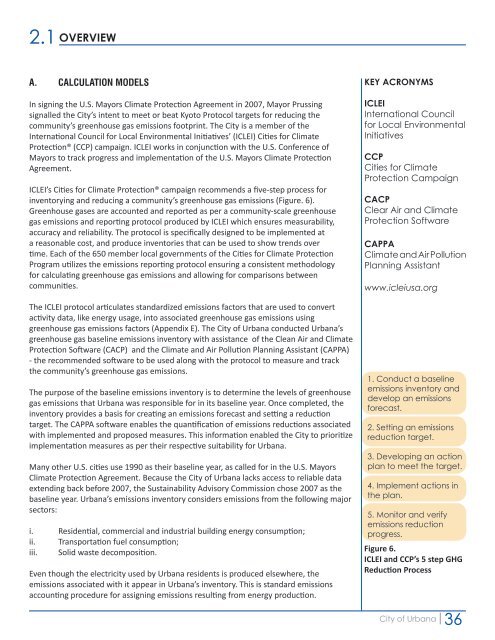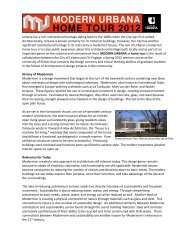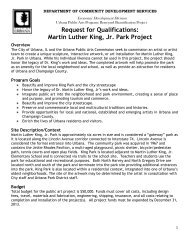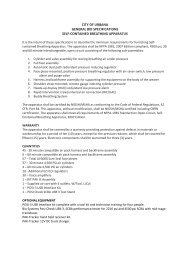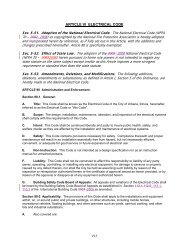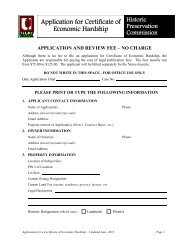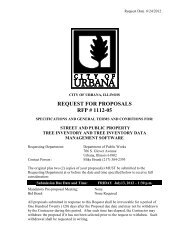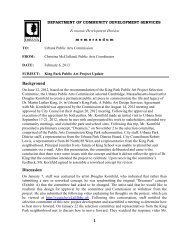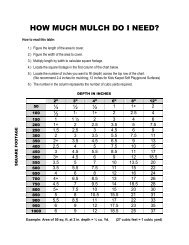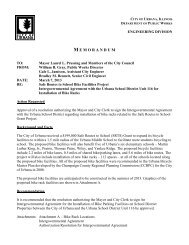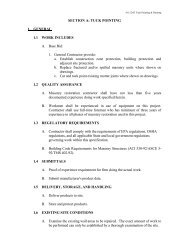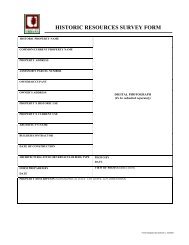CLIMATE ACTION PLAN - City of Urbana
CLIMATE ACTION PLAN - City of Urbana
CLIMATE ACTION PLAN - City of Urbana
- No tags were found...
Create successful ePaper yourself
Turn your PDF publications into a flip-book with our unique Google optimized e-Paper software.
2.1<br />
OVERVIEW<br />
A. CALCULATION MODELS<br />
In signing the U.S. Mayors Climate Protection Agreement in 2007, Mayor Prussing<br />
signalled the <strong>City</strong>’s intent to meet or beat Kyoto Protocol targets for reducing the<br />
community’s greenhouse gas emissions footprint. The <strong>City</strong> is a member <strong>of</strong> the<br />
International Council for Local Environmental Initiatives’ (ICLEI) Cities for Climate<br />
Protection® (CCP) campaign. ICLEI works in conjunction with the U.S. Conference <strong>of</strong><br />
Mayors to track progress and implementation <strong>of</strong> the U.S. Mayors Climate Protection<br />
Agreement.<br />
ICLEI’s Cities for Climate Protection® campaign recommends a five-step process for<br />
inventorying and reducing a community’s greenhouse gas emissions (Figure. 6).<br />
Greenhouse gases are accounted and reported as per a community-scale greenhouse<br />
gas emissions and reporting protocol produced by ICLEI which ensures measurability,<br />
accuracy and reliability. The protocol is specifically designed to be implemented at<br />
a reasonable cost, and produce inventories that can be used to show trends over<br />
time. Each <strong>of</strong> the 650 member local governments <strong>of</strong> the Cities for Climate Protection<br />
Program utilizes the emissions reporting protocol ensuring a consistent methodology<br />
for calculating greenhouse gas emissions and allowing for comparisons between<br />
communities.<br />
The ICLEI protocol articulates standardized emissions factors that are used to convert<br />
activity data, like energy usage, into associated greenhouse gas emissions using<br />
greenhouse gas emissions factors (Appendix E). The <strong>City</strong> <strong>of</strong> <strong>Urbana</strong> conducted <strong>Urbana</strong>’s<br />
greenhouse gas baseline emissions inventory with assistance <strong>of</strong> the Clean Air and Climate<br />
Protection S<strong>of</strong>tware (CACP) and the Climate and Air Pollution Planning Assistant (CAPPA)<br />
- the recommended s<strong>of</strong>tware to be used along with the protocol to measure and track<br />
the community’s greenhouse gas emissions.<br />
The purpose <strong>of</strong> the baseline emissions inventory is to determine the levels <strong>of</strong> greenhouse<br />
gas emissions that <strong>Urbana</strong> was responsible for in its baseline year. Once completed, the<br />
inventory provides a basis for creating an emissions forecast and setting a reduction<br />
target. The CAPPA s<strong>of</strong>tware enables the quantification <strong>of</strong> emissions reductions associated<br />
with implemented and proposed measures. This information enabled the <strong>City</strong> to prioritize<br />
implementation measures as per their respective suitability for <strong>Urbana</strong>.<br />
Many other U.S. cities use 1990 as their baseline year, as called for in the U.S. Mayors<br />
Climate Protection Agreement. Because the <strong>City</strong> <strong>of</strong> <strong>Urbana</strong> lacks access to reliable data<br />
extending back before 2007, the Sustainability Advisory Commission chose 2007 as the<br />
baseline year. <strong>Urbana</strong>’s emissions inventory considers emissions from the following major<br />
sectors:<br />
i. Residential, commercial and industrial building energy consumption;<br />
ii. Transportation fuel consumption;<br />
iii. Solid waste decomposition.<br />
Even though the electricity used by <strong>Urbana</strong> residents is produced elsewhere, the<br />
emissions associated with it appear in <strong>Urbana</strong>’s inventory. This is standard emissions<br />
accounting procedure for assigning emissions resulting from energy production.<br />
KEY ACRONYMS<br />
ICLEI<br />
International Council<br />
for Local Environmental<br />
Initiatives<br />
CCP<br />
Cities for Climate<br />
Protection Campaign<br />
CACP<br />
Clear Air and Climate<br />
Protection S<strong>of</strong>tware<br />
CAPPA<br />
Climate and Air Pollution<br />
Planning Assistant<br />
www.icleiusa.org<br />
1. Conduct a baseline<br />
emissions inventory and<br />
develop an emissions<br />
forecast.<br />
2. Setting an emissions<br />
reduction target.<br />
3. Developing an action<br />
plan to meet the target.<br />
4. Implement actions in<br />
the plan.<br />
5. Monitor and verify<br />
emissions reduction<br />
progress.<br />
Figure 6.<br />
ICLEI and CCP’s 5 step GHG<br />
Reduction Process<br />
<strong>City</strong> <strong>of</strong> <strong>Urbana</strong><br />
36


